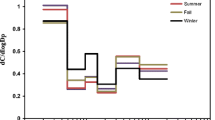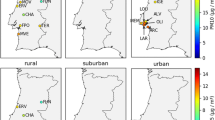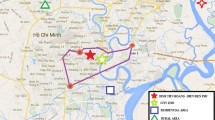Abstract
Purpose
The concentrations of PM10 mass, PM2.5 mass and particle number were continuously measured for 18 months in urban background locations across Europe to determine the spatial and temporal variability of particulate matter.
Methods
Daily PM10 and PM2.5 samples were continuously collected from October 2002 to April 2004 in background areas in Helsinki, Athens, Amsterdam and Birmingham. Particle mass was determined using analytical microbalances with precision of 1 μg. Pre- and post-reflectance measurements were taken using smoke-stain reflectometers. One-minute measurements of particle number were obtained using condensation particle counters.
Results
The 18-month mean PM10 and PM2.5 mass concentrations ranged from 15.4 μg/m3 in Helsinki to 56.7 μg/m3 in Athens and from 9.0 μg/m3 in Helsinki to 25.0 μg/m3 in Athens, respectively. Particle number concentrations ranged from 10,091 part/cm3 in Helsinki to 24,180 part/cm3 in Athens with highest levels being measured in winter. Fine particles accounted for more than 60% of PM10 with the exception of Athens where PM2.5 comprised 43% of PM10. Higher PM mass and number concentrations were measured in winter as compared to summer in all urban areas at a significance level p < 0.05.
Conclusions
Significant quantitative and qualitative differences for particle mass across the four urban areas in Europe were observed. These were due to strong local and regional characteristics of particulate pollution sources which contribute to the heterogeneity of health responses. In addition, these findings also bear on the ability of different countries to comply with existing directives and the effectiveness of mitigation policies.





Similar content being viewed by others
References
Alam A, Shi JP, Harrison RM (2003) Observation of new particle formation in urban air. J Geophys Res 108:4093–4107
Bigi A, Harrison RM (2010) Analysis of the air pollution climate at a central urban background site. Atmos Environ 44:2004–2012
Brook JR, Dann TF, Bonvalot Y (1999) Observations and interpretations from the Canadian fine particle monitoring program. J Air Waste Manage Assoc 49:35–44
Brown JS, Zeman KL, Bennett WD (2002) Ultrafine particle deposition and clearance in the healthy and obstructed lung. Am J Respir Crit Care Med 166:1240–1247
Brunekreef B, Forsberg B (2005) Epidemiological evidence of effects of coarse airborne particles on health. Eur Respir J 26:309–318
Cyrys J, Heinrich J, Hoek G et al (2003) Comparison between different traffic-related particle indicators: elemental carbon (EC), PM2.5 mass, and absorbance. J Exp Anal Environ Epidem 13:134–143
de Hartog J, Ayres JG, Karakatsani A et al (2010) Indoor and outdoor fine and ultrafine particles in relation to lung function in asthma/COPD patients in four European cities. Occ Env Med 67:2–10
Dye JA, Lehmann JR, McGee JK et al (2001) Acute pulmonary toxicity of particulate matter filter extracts in rats: coherence with epidemiologic studies in Utah Valley residents. Environ Health Perspec 109:395–403
Engelstaedter S, Tegen I, Washington R (2006) North African dust emissions and transport. Earth Sci Rev 79:73–100
Etyemezian V, Kuhns H, Gillies J et al (2003) Vehicle-based road dust emission measurement (III): effect of speed, traffic volume, location, and season on PM10 road dust emissions in the Treasure Valley, ID. Atmos Environ 37:4583–4593
Gehrig R, Hill M, Buchmann B et al (2004) Separate determination of PM10 emission factors of road traffic for tailpipe emissions and emissions from abrasion and resuspension processes. Int J Environ Pollut 22:312–325
Gomiscek B, Frank A, Puxbaum H et al (2004) Case study analysis of PM burden at an urban and a rural site during the AUPHEP project. Atmos Environ 38:3935–3948
Harrison RM, Jones M, Collins G (1999) Measurements of the physical properties of particles in the urban atmosphere. Atmos Environ 33:309–321
Harrison RM, Yin J, Mark D et al (2001) Studies of the coarse particle (2.5–10 μm) component in UK urban atmospheres. Atmos Environ 35:3667–3679
Harrison RM, Jones AM (2005) Multisite study of particle number concentrations in urban air. Environ Sci Technol 39:6063–6070
Hueglin C, Gehrig R, Baltensperger U et al (2005) Chemical characterisation of PM2.5, PM10 and coarse particles at urban, near-city and rural sites in Switzerland. Atmos Environ 39:637–651
Johansson C (2002) Source contributions of PM in Sweden—implications for abatement strategies. Institute of Applied Environmental Research (ITM). Stockholm. Presentation at ‘particles in the size of 2.5 to 10 μm in urban areas’ workshop, Berlin, Germany, November 4–6, 2002
Katsouyanni K, Touloumi G, Samoli E et al (2001) Confounding and effect modification in the short-term effects of ambient particles on total mortality: results from 29 European cities within the APHEA2 project. Epidem 12:521–531
Kavouras IG, Mihalopoulos N, Stephanou EG (1998) Formation of atmospheric particles from organic acids produced by forests. Nature 395:683–686
Korcz M, Fudała J, Kliś C (2009) Estimation of windblown dust emissions in Europe and its vicinity. Atmos Environ 43:1410–1420
Lalas DP, Asimakopoulos DN, Deligiorgi DG et al (1983) Sea-breeze circulation and photochemical pollution in Athens, Greece. Atmos Environ 17:1621–1632
Last JA, Ward R, Temple L et al (2004) Ovalbumin-induced airway inflammation and fibrosis in mice also exposed to ultrafine particles. Inhal Toxicol 16:93–102
Lianou M, Chalbot M-C, Kotronarou A et al (2007) Dependence of home outdoor particulate mass and number concentrations on residential and traffic features in urban areas. J Air Waste Manage Assoc 57:1507–1517
Maenhaut W, Raes N, Chi XG et al (2005) Chemical composition and mass closure for fine and coarse aerosols at a kerbside in Budapest, Hungary, in spring 2002. XRay Spectrom 34:290–296
Marple VA, Rubow KL, Turner W et al (1987) Low flow rate sharp cut impactors for indoor air sampling, design and calibration. J Air Pollut Control Assoc 37:1303–1307
McDonnell WF, Nishino-Ishikawa N, Petersen FF et al (2000) Relationships of mortality with the fine and coarse fractions of long-term ambient PM10 concentrations in nonsmokers. J Exp Anal Env Epidem 10:427–436
Oberdoster G (2001) Pulmonary effects of inhaled ultrafine particles. Int Arc Occup Environ Health 74:1–8
Peng RD, Dominici F, Pastor-Barriuso R et al (2005) Seasonal analyses of air pollution and mortality in 100 US cities. Am J Epidemiol 161:585–594
Pope CA, Burnett RT, Thun MJ et al (2002) Lung cancer, cardiopulmonary mortality, and long-term exposure to fine particulate air pollution. J Am Med Assoc 287:1132–1141
Putaud JP, Raes F, Van Dingenen R et al (2004) European aerosol phenomenology-2: chemical characteristics of particulate matter at kerbside, urban, rural and background sites in Europe. Atmos Environ 38:2579–2595
Puustinen A, Hämeri K, Pekkanen J et al (2007) Spatial variation of particle number and mass over four European cities. Atmos Environ 41:6622–6636
Roorda-Knape MC, Janssen NAH, de Hartog JJ et al (1998) Air pollution from traffic in city districts near major motorways. Atmos Environ 32:1921–1930
Russell M, Allen DT, Collins DR et al (2004) Daily, seasonal, and spatial trends in PM2.5 mass and composition in southern Texas. Aerosol Sci Technol 38:14–26
Ruuskanen J, Tuch TH, Brink HT et al (2001) Concentrations of ultrafine, fine and PM2.5 particles in three European cities. Atmos Environ 35:3729–3738
Samet JM, Dominici F, Curriero FC et al (2000) Fine particulate air pollution and mortality in 20 U.S. cities, 1987–1994. New Engl J Med 343:1742–1749
Sardard SB, Fine PM, Yoon H et al (2004) Associations between particle number and gaseous co-pollutant concentrations in the Los Angeles Basin. J Air Waste Manage Assoc 54:992–1005
Snel SC, Larssen S (2004) Trends in PM10 concentrations in European cities 1997–2002. Norwegian Institute for Air Research, Kjeller
Van Dingenen R, Raes F, Putaud JP et al (2004) A European aerosol phenomenology-1: physical characteristics of particulate matter at kerbside, urban, rural and background sites in Europe. Atmos Environ 38:561–2577
Vautard R, Bessagnet B, Min C et al (2005) On the contribution of natural Aeolian sources to particulate matter concentrations in Europe: testing hypotheses with a modelling approach. Atmos Environ 39:3291–3303
Acknowledgements
The study was done within the framework of the “Relationship between Ultrafine and fine Particulate matter in Indoor and Outdoor air and respiratory Health (RUPIOH)” project. The project was funded by the EU Quality of Life and Management of Living Resources programme, contract QLRT-2001-00452.
Author information
Authors and Affiliations
Corresponding author
Additional information
Responsible editor: Euripides Stephanou
Rights and permissions
About this article
Cite this article
Lianou, M., Chalbot, MC., Kavouras, I.G. et al. Temporal variations of atmospheric aerosol in four European urban areas. Environ Sci Pollut Res 18, 1202–1212 (2011). https://doi.org/10.1007/s11356-011-0471-y
Received:
Accepted:
Published:
Issue Date:
DOI: https://doi.org/10.1007/s11356-011-0471-y




